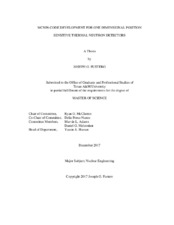| dc.contributor.advisor | McClarren, Ryan G | |
| dc.contributor.advisor | Perez-Nunez, Delia | |
| dc.creator | Fustero, Joseph G | |
| dc.date.accessioned | 2018-09-21T15:37:46Z | |
| dc.date.available | 2018-09-21T15:37:46Z | |
| dc.date.created | 2017-12 | |
| dc.date.issued | 2017-12-11 | |
| dc.date.submitted | December 2017 | |
| dc.identifier.uri | https://hdl.handle.net/1969.1/169607 | |
| dc.description.abstract | The development of position sensitive thermal neutron detectors (PSD’s) began soon after the initial development of early model thermal neutron detectors. One dimensional (1D) PSD’s report not only neutron counts but the axial position of the neutron interaction within the detector gas volume. These detectors maintain a high level of fidelity except when the neutron interaction takes place close to the gas-shell boundary.
The use of PSD’s in order to characterize the spatial distribution of the thermal neutron field will become more commonplace as the technology has become less expensive. These experiments, however, must be validated against simulation results in order to assure their quality. The stochastic radiation transport code MCNP6 was used in order to provide these simulation results due to its large user base and its compatibility with the Parallel Deterministic Transport (PDT) code.
It was found that it is possible to use MCNP6 to accurately simulate 1D PSD’s without heavily editing the source code. MCNP6 was used to simulate both the position of the neutron interaction as well as the predicted detector response due to the charge generation resultant of this interaction. This was done by writing a TALLYX modification to the default energy deposition F6 tally for charged particles which result from a neutron interaction. Additionally, it was found that using the PTRAC particle tracing utility for events contributing to the F6 tally for the cell corresponding to the detector gas volume was also appropriate for determining the location of the neutron interaction and the corresponding detector response due to charge collection on the anode wire.
These simulations were run for a line detector test problem, a modified already completed impurity model experiment, and a future localized source experience. For all of these simulations the expected spatial distribution (including symmetries) and notable physical features (wall effect due to surface leakage of heavy charged particles) was observed. The computational expense did not differ significantly from a simulation using the default MCNP6 tallies. | en |
| dc.format.mimetype | application/pdf | |
| dc.language.iso | en | |
| dc.subject | Neutron detection | en |
| dc.subject | position sensitive detector | en |
| dc.title | Mcnp6 Code Development for One Dimensional Position Sensitive Thermal Neutron Detectors | en |
| dc.type | Thesis | en |
| thesis.degree.department | Nuclear Engineering | en |
| thesis.degree.discipline | Nuclear Engineering | en |
| thesis.degree.grantor | Texas A & M University | en |
| thesis.degree.name | Master of Science | en |
| thesis.degree.level | Masters | en |
| dc.contributor.committeeMember | Adams, Marvin L | |
| dc.contributor.committeeMember | Melconian, Daniel G | |
| dc.type.material | text | en |
| dc.date.updated | 2018-09-21T15:37:47Z | |
| local.etdauthor.orcid | 0000-0001-8112-1856 | |


